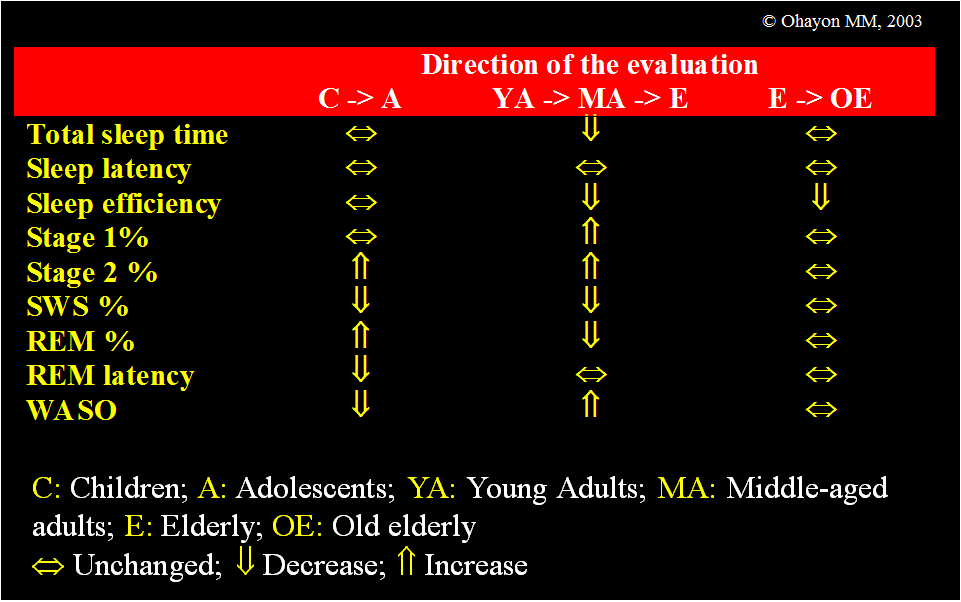Normative Data: Conclusions
First created | 01/12/1999
Last edited |
Sleep patterns evolve across the normal aging process in complex ways. Chronological age in elderly people does not always match physiological age.
Therefore, changes in sleep patterns may happen earlier, i.e., at a younger age, for some individuals or at an older age for others.
Moreover, epidemiological and other studies suggest that much of the sleep disturbance typically seen in old age is likely the result of medical co-morbidities than age per se.
Nevertheless, four age-related changes have been consistently demonstrated in polysomnographic (PSG) studies of sleep architecture:
- total sleep time,
- sleep efficiency, and
- slow wave sleep all decrease, while
- wake after sleep onset increases with age.
However, a number of PSG sleep characteristics remain uncertain as regard their evolution with age:
- sleep latency has been reported to increase with age in some studies, while several other studies found no significant changes with age). Likewise, a number of studies found no significant differences with age for
- percentage of stage 1and
- stage 2 while many others reported an increase with age of these stages).
- Similarly, REM sleep has reported to decrease with age in several studies while many other studies found no such association with age.
Why such discrepancies between the studies?
Several factors may be responsible for the difficulties identifying age trends in sleep architecture of apparently healthy subjects. For example: small sample sizes; inconsistency in controlling factors that may influence sleep, such as mental or physical illness; uncontrolled use of alcohol, drugs or medications; or insufficient screening for sleep disorders.
Epidemiological studies indicate that as much as 50% of the older population complains of significant sleep disturbance.
Numerous age-related sleep changes have been demonstrated both by self report and objective findings:
- increased Time in Bed
- increased Sleep Latency
- increased nighttime wakefulness
- decreased Total Sleep Time
- decreased Sleep Efficiency
- increased Stages 1 and 2
- decreased Stages 3 and 4
- decreased REM(?)
Meta analysis of the "normative" objective sleep literature allows us to:
- determine if these findings are accurate.
- distinguish between age-changes across the adult life-span and age-changes within the older adult portion of the population.
- determine the impact of key variables such as gender and health on objective sleep.
SUMMARY OF THE SUBJECTIVE FINDINGS
In the general population:
- Sleep duration does not change very much with age:
- Sleep latency increased only at 75 years and older.
- At 75 years and older, bedtime became earlier.
the median remained at 7 hours from 25 years until very old age.
SUMMARY OF THE OBJECTIVE FINDINGS

CONCLUSION
Accurate "normative" data is necessary to detail what types of sleep patterns can be expected as individuals age and what might be considered pathological deviation from those norms.
This meta analysis clearly illustrates the importance of strict screening for subject health, use of habitual bedtimes, etc. to ensure that data may be considered "normative".
This meta analysis suggests that most age-related objective sleep changes occur in the early and mid years of the human life span and that these changes effectively asymptote in older adults.
In fact, the sleep of healthy older adults remains relatively constant from age 60 to the mid 90s, although older adults can expect their sleep efficiency to decline in a slow but continuous manner.
This lack of significant age-related sleep changes in healthy older adults may well help account for the fact that epidemiological studies report that only somewhere between 40 and 60% of older adults complain of significant sleep problems.
It is important to remember that the other half of the population does not complain!
POLLING THESE STUDIES HAVE SHOWED THAT IN OBJECTIVE DATA:
- TOTAL SLEEP TIME DOES NOT CHANGE WITH BETWEEN 20 AND 60 YEARS WHEN LIMITING TO "PERFECTLY HEALTHY" SUBJECTS
- SLEEP LATENCY DOES NOT CHANGE WITH AGE
- PERCENTAGE OF STAGE 1 INCREASES WITH AGE FROM YOUNG ADULTS UNTIL 65 YEARS
- PERCENTAGE OF STAGE 2 INCREASES WITH AGE FROM 5 YEARS UNTIL 65 YEARS
WHAT STILL NEED TO BE DONE?
- Racial comparisons are still very scant both for objective and subjective sleep parameters.
- Objective sleep data for individuals aged between 35 and 60 years old are also rare.
FUTURE STUDIES THAT WILL EVALUATE THE SLEEP IN HEALTHY INDIVIDUALS NEED TO APPLY VERY STRICT INCLUSION CRITERIA: IN A SMALL SAMPLE, 2 OR 3 SUBJECTS WITH SOME PHYSICAL, MENTAL OR SLEEP PROBLEMS MAY JEOPARDIZE THE RESULTS.
